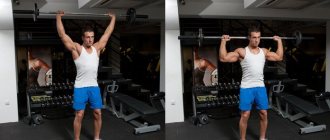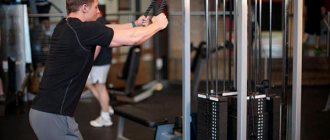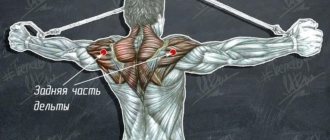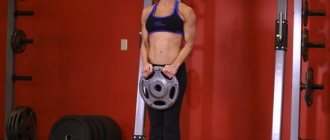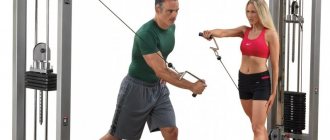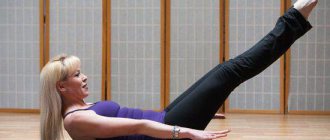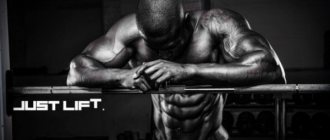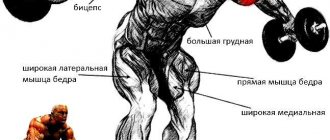Author: Timko Ilya - the ruler of the entire site and fitness trainer | more details >> Rod. 1984 Trained since 1999 Trained since 2007. Author and creator of the site tvoytrener.com. CCM in powerlifting. Champion of Russia and South Russia according to AWPC. Champion of the Krasnodar region according to IPF. 1st category in weightlifting. 2-time winner of the Krasnodar Territory championship in t/a. Author of more than 700 articles on fitness and amateur athletics. Author and co-author of 5 books.
Place in the ranking of authors:
out of competition
(become an author)
Date:
2012-05-29
Views:
386,622
Rating:
4.8
| All articles by the author >> | Medals articles >> |
Articles are loading...
| Article medals: | more than 100 thousand views |
Why medals are given to articles:
| Bronze medal: | |
| 1. The article is in the TOP 100 2. The article has more than 3. The article has more than 100 | |
| Silver medal: | |
| 1. The article is in the TOP 50 2. The article has more than 3. The article has more than 500 | |
| Gold medal: | |
| 1. The article is in the TOP 10 2. The article has more than 1 3. The article has more than 1,000 | |
Main muscles - anterior delta Additional - middle delta and triceps Difficulty - easy
Benefits and disadvantages of exercise
The first and main advantage is that while lying on an incline bench, the pectoral muscles are used to a greater extent during the press (including the triceps and deltoids). While when working with a barbell, the load is distributed almost evenly across the chest, deltoids and triceps. Therefore, for the target muscle, the dumbbell bench press at an angle becomes a higher priority.
Read more about the angled barbell press →
Main advantages:
- Working out all parts of the pectoral muscles;
- Ability to manipulate the load focus using tilt;
- Powerful stretch;
- Development of coordination;
- Increased range of motion.
Almost all the shortcomings relate to the execution technique. Basically, they are leveled out by mastering all the features of the movement and following the recommendations for implementation. Due to the need to work, almost sitting at an angle (applies only to the backrest position of 45 degrees), an important condition is the concentration of the load on the chest and controlled execution (especially while lowering the weight to the chest).
The only pronounced disadvantage of performing the movement at an upward angle is the increased risk of injury due to powerful stretching.
It appears mainly when working with heavy weights and at critical points (throwing a projectile from a sitting position and completing an approach).
Basic mistakes
No warm-up
For the thousand and first time, let’s name the most common mistake beginners make when they do, among other things, lifting dumbbells while sitting - lack of warm-up. Before performing the exercise, you need to thoroughly warm up the joints and muscles of the shoulders.
If necessary, you need to lubricate the skin around them with a warming ointment (follow the instructions so as not to get a negative effect from the use of warming ointments, for example, severe burning during exercises). Then you need to perform a warm-up approach with light weight. Then start working.
https://youtu.be/QKnz7aN-i6Y
If you don’t do this, you can get injured and forget about any chest and shoulder exercises for six months. Unless, you will not perform these elements with your healthy hand.
Performing a one-arm press
Seated dumbbell lifting is sometimes called a military press with dumbbells. This name reflects the whole essence - the word “dumbbells” is used in the plural. Just like in the name “seated dumbbell press”.
Some people try to perform this element with one hand. In this case, a traumatic load occurs on the side of the spine adjacent to the working arm.
There are times when one shoulder is injured. It is not possible to perform an overhead dumbbell press in such a situation. Then the person tries to pump only the second, healthy delta. This leads to unilateral hypertrophy of the brachialis muscle. It will look funny, but that's all. We do not recommend doing this.
There is an alternate lifting of dumbbells, called the Arnold press (in honor of the same actor who played the role of “Terminator”). But even there the exercise is performed with two dumbbells.
You can perform various abductions with one hand.
Breath
If you breathe incorrectly, you will not be able to ensure 100% work of the shoulder muscle.
Until you take the starting position, breathe as you want. As soon as you sit down, prepare to exhale. You need to lift the weight exactly when you exhale.
At the final top point, when the arms are straightened (by the way, you should not straighten them completely), the exhalation should be completed. As soon as you start lowering the dumbbells, inhale the air. At the bottom point (when the hand with the dumbbell reaches the shoulder), prepare to exhale again.
Take care not to hold your breath. Only continuous, for the duration of the load.
Jerks, cheating, “walking” elbows and back
The following especially applies to beginners, since experienced athletes do not make such mistakes when performing a bench press.
Snatches occur when a beginner has chosen a weight that is too heavy or light for himself. If the dumbbell is heavy, he cannot lift it without a jerk. If it’s light, the excess force pushes the weight with more force than required. In both cases the technique is incorrect. There is a risk of injury.
If you decide to read, have a partner help you lift the dumbbells. This is better than using a jerk to bring them to the top position to practice the negative.
If you perform heavy weight dumbbell raises without back support, your body will move back and forth slightly. Why do you need extra stress on the spinal column?
Beginners often do not understand the meaning of the exercise; their elbows “walk” in different directions during execution. Ask your partner to ensure that your elbows move strictly vertically (proper technique).
The nuance here is this: while pressing dumbbells, the triceps, trapezius and deltoids work. If the elbows are not fixed, the load goes to the triceps (incorrect technique). This means only one thing - the shoulders will be pumped much worse. You will waste time, but will not get results.
Another side of the coin is the load on the deltoids themselves. If the elbows are not fixed during the exercise, the chance of damaging the brachialis muscle bundles increases. Anyone who knows anatomy can easily explain this.
And also, watch your hands so that they move synchronously. By the way, sit so that there is a mirror on one side (not just in front of you). Look to the side sometimes. The rest of the time, keep your head straight.
Overtraining
The shoulder muscles are used during barbell presses, dips, and parallel bars. When you do dumbbell raises, keep this in mind. You should not combine seated dumbbell press and barbell bench press on the same day. Just like any other exercises for the shoulder muscles, dips, dumbbell flyes, etc. These muscles are fragile, they are easy to “clog” and damage.
https://youtu.be/8KYbd6whr6c
And finally, let us remind you once again that the standing dumbbell press is more suitable for experienced athletes. Don't hurt yourself!
What muscles work
When performing a dumbbell bench press, almost the same muscles work as when working with a barbell. Also, due to the need to hold the weight with each hand separately, additional stabilizer muscles are involved in the work. However, due to the increased amplitude and ability to maximally “open” (or unfold) the chest, the incline press works the target area better than other exercises.
Main load:
- Breasts;
- Triceps;
- Deltoid (anterior bundle).
The secondary (minimal) load falls on the forearms and biceps; they mainly act as antagonists for maintaining the desired position of the arms.
How to do a standing barbell press correctly
If you want to have big shoulders, do standing barbell presses and increase the working weights. Everything about the correct bench press technique, videos and analysis of the main mistakes are in the Soviet Sport manual.
BAR PRESS STANDING. WHAT MUSCLES WORK
The standing barbell chest press, or military press, is a key exercise for developing large shoulders. When performing it, the anterior and middle bundles of deltoid muscles work; the rear delta, triceps and trapezius muscles receive indirect load.
Choosing a protein - composition, amount of protein, sellers' tricks
The shoulders respond well to heavy weights. The standing barbell press is exactly the exercise where you can increase the weight of the projectile for a long time, in contrast to isolating exercises for the deltoids. Record holders of the “military bench press” are able to lift a barbell weighing up to two hundred kilograms or more. Until 1972, this exercise was one of the competitive movements in athletics, along with the snatch and clean and jerk. He was excluded because a number of athletes began to use “cheating”: instead of clean lifts, they pressed the barbell with a shvung - they pushed it out by slightly squatting and straightening their legs. It was difficult for the judges to determine a clean bench press by eye.
BAR PRESS STANDING. TECHNIQUE
Grab the barbell from the racks with a grip slightly wider than shoulder-width. Legs stand straight, toes slightly pointed to the sides. The back is tense, a slight arch in the lower back is acceptable. Place the barbell on your chest and then begin to gently press it upward until your elbows are straight. At the top point, the bar should be above the crown.
Smoothly lower the barbell to the starting position. You did one rep of the standing press.
You can watch the correct exercise technique in this training video:
BAR PRESS STANDING. COMMON ERRORS
— before performing a standing barbell press, you need to stretch your shoulders well. Without warming up, an exercise - especially if you do it with heavy weights - can lead to muscle injuries, sprains, and joint inflammation;
- do the movement in full amplitude: lower the barbell below the level of the chin - this will allow you to work out the front deltoids more efficiently;
- Avoid jerky movements. The bar should move smoothly and under control up and down. Do not lower the barbell to your chest suddenly;
- the head looks forward all the time - this helps to maintain a straight body position;
- Make sure that the body is straight. A strong deflection in the lower back while performing a standing barbell press can lead to spinal injury. Lower the weight on the bar if you can't finish the set without arching your lower back on the last reps. Use a weightlifting belt to support your lower back.
https://youtu.be/e-0N7rJHd3Q
BAR PRESS STANDING. EXERCISE VARIATIONS
Often, the standing barbell press from the chest is replaced with another exercise - the standing barbell press from behind the head. This type of press allows you to engage the rear deltoids more, but we do not recommend using it. The shoulder joint in the overhead bench press is in an unnatural position for itself and experiences overload - this can injure it.
An alternative to the classic standing barbell press is the dumbbell press (standing or seated). Dumbbells allow you to increase the range of motion.
BAR PRESS STANDING. TRAINING
The standing barbell press is a good way to start training your shoulders - while you are still full of strength and can handle heavy weights. After completing the basic bench press, move on to isolation exercises, such as dumbbell flyes and dumbbell front raises. Between the bench press and isolation, you can do a few more sets of barbell rows to the chin - this will allow you to “break through” the middle deltoids.
Safety precautions - what to do if crushed by a barbell
Don't forget that when you press a barbell while standing, the posterior deltoid muscles work to a lesser extent. To achieve uniform development of the deltoid muscles, include exercises for the rear delts in your training - bent-over dumbbell flyes, cable machine rows. Exercises for building a bunch of deltoids can be done on the day when you train your back - if you decide that there are too many exercises for deltoids for one day.
ATTENTION! Before starting training, consult
Eat with a doctor!
https://youtu.be/clMtjt4cwAc
Which angle to choose and what is the difference: 30 or 45 degrees
One of the main benefits of the exercise is flexibility, which manifests itself in the ability to shift the load to different areas.
- When working at an angle of 30 degrees, the load falls evenly on all areas of the chest.
- When performing the exercise at a 45-degree incline, the focus shifts to the top of the pecs (which is often classified as a lagging area).
And also read, the best exercises for the upper chest →
It is important to take into account that when pressing at an angle of 45 degrees, the anterior deltoids are activated much more strongly and part of the load is switched to it. This can become a disadvantage only in cases where the training was preceded by active development of the deltas (with increased volume, the anterior fascicle will recover worse).
In general, the choice depends on training goals, priorities and individual conditions (lagging areas of the chest for a particular athlete). A tilt of 30 degrees is considered universal and is used most often.
Execution technique
In the technique of bench press on an inclined bench at an upward angle, two phases are considered key - the immediate execution of the element and entering the starting position. Moreover, most injuries occur precisely at the stage of weight gain, so this stage should be considered separately.
The technique of entering a position is performed in two versions: independently and with the help of a partner.
- In the first option, the dumbbell is thrown using the legs . The implements are placed on the hips, after which they are lifted into position with a push and simultaneous force of the arms and hips.
- The option with a partner is safer. The partner simply places the projectiles one by one in the hands of the athlete, who has already taken the starting position.
Technique for performing dumbbell presses on an incline bench:
- Lie down on a bench, raise your arms with dumbbells up (fully straightened) so that your forearms are perpendicular to the floor. The back and the back of the head are pressed tightly against the back, the feet rest on the floor to fix the position of the body.
- Begin to slowly bend your elbows, lowering the dumbbells down.
- Squeeze your shoulder blades and push your chest forward as much as possible to stretch the muscles.
- Without pausing, press the weights back to the starting position at a faster pace.
- At the top point, the dumbbells should not touch each other.
Equipment
If you think that you can come to training in a home T-shirt and pants, then you are deeply mistaken. You will need to purchase a special suit that will fit snugly to your body and not create any discomfort.
https://youtu.be/fEi7nKj5uTA
To prevent painful calluses on your hands, buy special gloves.
To protect your spine from damage, you must wear an athletic belt; it will evenly distribute the load across your entire back.
To protect yourself from chest injuries, you can place a pillow on your chest. Choose shoes that are not high and as light as possible.
Recommendations: how to implement them in training
In fact, working with dumbbells and a barbell are variations of the same exercise with a similar motor pattern (but shifted emphasis). Usually these options are alternated to fully work out the entire group.
- The training regimen for men (number of repetitions, sets, volumes, etc.) is no different between bench press with dumbbells and with a barbell. Classic 8-10 reps in 3-4 sets for weight and multi-rep mode with an emphasis on increasing strength endurance.
- Girls are recommended to work in the range of 10-12 repetitions; this is the optimal average option, in which they can achieve both an increase in chest mass and improved muscle definition.
Due to the specific nature of the movement, the dumbbell bench press at an angle with your head up is usually placed immediately after working with the barbell. This allows you to better “load” the chest without the strong involvement of other groups.
Read more about the barbell bench press →
How to replace the exercise
There are two obvious replacements for the dumbbell incline press:
- A similar movement with a barbell (less priority, since the pecs are used a little worse);
- The hammer press is an ideal option that is almost a complete duplication. Also, this technique is devoid of the main disadvantages that are associated with holding free weight in the hands.
Barbell Incline PressHummer press
